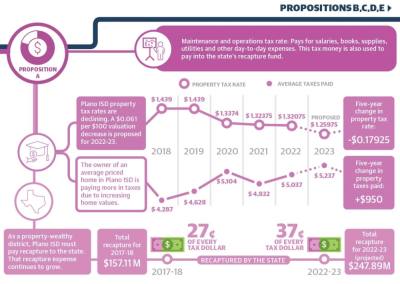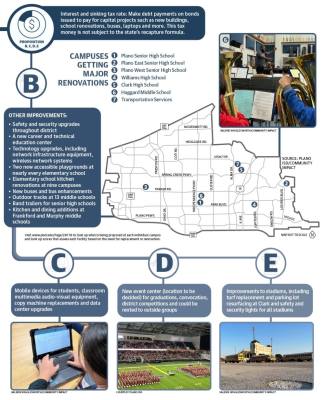But district officials say they want voters to know the why and the how behind these measures. If voters say yes, the measures would not only generate about $9 million more for the district’s day-to-day operations but also fund nearly $1.5 billion worth of critical infrastructure upgrades needed at its 73 campuses and other facilities.
The first proposition on the ballot would set the district’s property tax rate. PISD is proposing a decrease of $0.061 per $100 valuation compared with its current tax rate.
The remaining four measures would allow the district to issue bonds and take on debt to pay for a host of capital projects, including campus renovations and security and technology upgrades. PISD officials say passage of the four bond measures will have no effect on the district’s tax rate, but the language that voters see on the ballot describes each of these measures as a property tax increase under state law. The tax increase comes from the debt the district will incur.
“People read that, and if they haven’t spent 15 minutes of educating themselves, it’s hard for a lot of people to get over that hurdle,” said Johnny Hill, who is PISD’s deputy superintendent for business and employee services.
A website taking a deep dive into each ballot measure is at www.pisd.edu/election2022. The site includes text and charts to help voters understand the complexities of school finance. Online tools let voters search for the improvements proposed at each campus and review scores that rate the renovation and replacement needs for each PISD building.
District officials say they are encouraging voters to ask questions and get involved.
“Our goal is to share information about our elections with as many people as possible so they can make an informed decision when they go to the polls,” Superintendent Theresa Williams said in an email.
Educating voters
One of the biggest challenges, according to district officials, is making sure voters understand what is on the ballot and why it is needed.
“When they say, ‘Wait a minute, you’re telling me I can get $1.5 billion in bond debt and an increase in M&O [maintenance and operations] by $9 million and still have a tax rate decrease of 6 cents?’” PISD Board President David Stolle said. “Yes, that is exactly what we are telling you we can do.”
School districts get most of their revenue from local property taxes, which are generated by a tax rate divided into two parts: maintenance and operations, or M&O, and interest and sinking, or I&S, also called debt service.
Because PISD is considered a property-wealthy district, a portion of the tax dollars collected for maintenance and operations are recaptured by the state and used elsewhere.
In the 2017-18 school year, PISD paid more than $157.11 million in recapture. This year the district is projected to pay more than $247.89 million.
"Recapture is becoming everybody's problem now," PISD Board Vice President Nancy Humphrey said.
She and others in PISD are already advocating for change with state lawmakers. But any changes that come from the Texas legislative session that begins in January will not help with this year's budget.
Humphrey said part of the problem with the state's school finance formula is that it does not allow for inflation. The funding formula also does not account for staff raises, which district officials say are needed because of the competitive job market.
Hill said education is a labor-intensive business with about 86% of its operating budget tied to payroll.
Tax rate changes
PISD has tapped into federal funds tied to the pandemic to cover some costs. And it has dipped into its fund balance in recent years to square expenses with available revenue. But those measures are temporary.
“We currently have a $40 million deficit,” Stolle said, adding that without the tax rate election, “Our only way to reduce our cost is to reduce people, and
that means shutting down what we can currently off er.”
The increase in property values this year allowed the district to lower its I&S tax rate by about 3 cents and still have the capacity to finance the proposed projects on the ballot.
"Plano ISD has a history of paying down debt early, and the increased TAVs—or taxable assessed values—have put us in a position to present these bonds without raising the adopted I&S [or debt portion] of your tax rate," Williams said.
As for funding school operations, state law caps how much a district can collect through its M&O rate. This year's cap requires the district to lower its M&O rate by about 6 cents.
Through Proposition A on the ballot, the district wants to use some of what it had been collecting from the I&S tax rate and assign it to the M&O side. The board of trustees has already approved the lowered tax rate for I&S. But because the district's M&O rate is higher than what state law allows, the district needs permission from voters.
"We want to get the biggest bang for our buck and have the least amount of impact on taxpayers," Hill said.
Ballot language
The need for voter education was evident with the results of a survey PISD conducted between June 29 and July 5 about the election. The survey of 400 respondents has a margin of error plus or minus 4.9%.
The survey found that based on wording on the ballot, 52% of respondents favored Proposition A. Among those against the proposal, 83% said that property taxes were too high.
But after learning more about the district's plans, the support for Proposition A increased to 68%, the survey showed.
Survey results showed a similar pattern for the four bond propositions. Respondents were initially less supportive of the propositions based on the language on the ballot.
The most significant change came with Proposition E, which calls for renovations to Clark, Kimbrough and Williams stadiums. Improvements include adding safety and security lights, adding fencing and renovating restrooms. A big chunk of funds would go toward resurfacing the Clark stadium parking lot, which board members have likened to driving on "craters on the moon" because of its poor condition.
After an initial reading of the ballot measure, only 29% of survey respondents were in favor. But after learning details, 57% favored that bond proposal, according to the survey.
Backing the bonds
Marshall Jackson and Rick Cinclair were part of a 70-member task force to help determine which bond projects to put on the ballot. Their bond task force met for months to whittle down the district's needs to the nearly $1.5 billion in proposed projects.
"We are a district of excellence," Cinclair said. "We just have facilities that need some love."
The task force determined, for example, that Plano Senior High needs more than $205 million in major renovations to bring it up to today's standards. Task force members also found it would be more cost effective to build a replacement campus for Haggard Middle School rather than renovate the existing campus.
Jackson, who chaired the group, said the proposed event center requires more explanation than what is on the ballot. PISD spends more than $275,000 a year to rent facilities for big events, including graduations and teacher convocations.
An event center would not only give the district a place to hold events and district competitions, but it would also generate revenue when the district leases it to outside groups, Jackson said.
"We can cut our expenses and create a revenue stream by having the event center," he said. "It's a win-win for Plano."
Jackson and Cinclair are now part of a political action committee called Friends of Plano ISD to advocate for the passage of all five measures on the November ballot. The pair said there has been some hesitancy over the years to ask voters to put money toward PISD facilities. But further delays will only increase costs later, they said.
"We cannot kick the can down the road anymore," Cinclair said.








